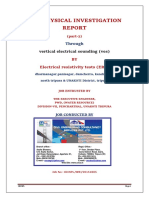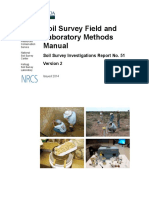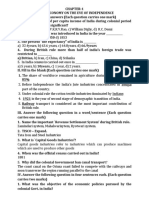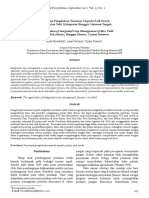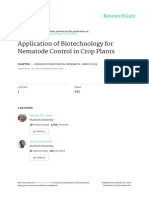Professional Documents
Culture Documents
SWOT (Strenghts, Weaknesses, Opportunities and Threats) Analysis of Farmer Producer Companies in North-Eastern Karnataka
0 ratings0% found this document useful (0 votes)
13 views4 pagesThe study was conducted in purposively
selected North-Eastern districts of Karnataka stat
Copyright
© © All Rights Reserved
Available Formats
PDF, TXT or read online from Scribd
Share this document
Did you find this document useful?
Is this content inappropriate?
Report this DocumentThe study was conducted in purposively
selected North-Eastern districts of Karnataka stat
Copyright:
© All Rights Reserved
Available Formats
Download as PDF, TXT or read online from Scribd
0 ratings0% found this document useful (0 votes)
13 views4 pagesSWOT (Strenghts, Weaknesses, Opportunities and Threats) Analysis of Farmer Producer Companies in North-Eastern Karnataka
The study was conducted in purposively
selected North-Eastern districts of Karnataka stat
Copyright:
© All Rights Reserved
Available Formats
Download as PDF, TXT or read online from Scribd
You are on page 1of 4
Volume 6, Issue 11, November – 2021 International Journal of Innovative Science and Research Technology
ISSN No:-2456-2165
SWOT (Strenghts, weaknesses, Opportunities and
Threats) Analysis of Farmer Producer Companies in
North-Eastern Karnataka
Shweta Karadipatil*1 Dr. D.M. Chanadargi2
PhD Scholar Director of Extension,
Department of Agricultural Extension Education University of Agricultural Sciences,
University of Agricultural Sciences, Raichur Karnataka, India- 584104
Raichur Karnataka, India- 584104
Dr. S. B. Goudappa3 Dr. Basavaraj Hulagur4
Dean Student Welfare, Assistant Professor,
University of Agriculture Sciences, University of Agriculture Sciences,
Raichur Karnataka, India- 584104 Raichur, Karnataka, India- 584104
Dr. D.G.Satihal5 Dr. Pampanna, Y6
Senior Farm Superintendent and Head, Assistant Professor,
Agricultural Research Station Bheemarayangudi, UAS, Main Agricultural Research station, UAS,
Raichur Karnataka, India- 584104 Raichur, Karnataka, India- 584104
Abstract:- The study was conducted in purposively I. INTRODUCTION
selected North-Eastern districts of Karnataka state. A
total of ten Companies were purposively selected from the Farmer Producer Organization/Company is a legal
region in the year 2019. The respondents for the study entity formed by group of farmers or primary producers, viz.,
were the members holding a share in the Company. The agriculture farmers, milk producers, fisherman, small tea
list of registered members was taken from each company growers, weavers, craftsman etc., works closely in support of
growing multiple agriculture and horticulture crop thus the Department of Agriculture and Co-operation and the
25 respondents were randomly selected. Thus, a total of various state governments to enhance production,
260 registered member farmers were selected for the productivity, and profitability of small farmers (Anonymous,
study. Ex-post-facto and exploratory research design was 2013). The basic purpose envisioned for the FPCs is to
used for the study. The collected data was analyzed using collectivize small farmers for backward linkage for inputs
frequency, percentage and standard deviation and ranks like seeds, fertilizers, credit, insurance, knowledge, and
were given accordingly based on the responses. With extension services; and forward linkages such as collective
respect to SWOT analysis, Provision of equity grant was marketing, processing, and market-led agriculture production
identified as major strength in FPCs. The arrangements (Mondal, 2010). Producer organization/company increases
made by FPC to their members by procuring the the skills, revenue and bargaining power of the smallholder
vegetables and fruits giving them opportunity to sell farmers in the production and marketing of their produce.
directly to consumers at increased price. As consumers Producer Companies also disseminate technical knowledge to
were ready to pay more for fresh fruits and vegetables this its members, improve their production efficiency, reduce the
added growers with a price advantage was expressed as transaction costs, market the final produce and are even
major strength by FPC members. The members were of successful in capacity building thereby, fabricating the social
the opinion that whenever the government procures their capital. In this context, it is important to know the strengths
produce, they will get more than market price values and and opportunities which act as positive elements in growth of
the immediate payments through direct benefit transfers the company. As well weaknesses and threats are to be known
have been helping solve financial problems. Higher to rectify the problems and make the company capable of
transportation cost increases the sale price of produce and overcoming such threats and weaknesses.
competition with private companies as a threat was
expressed by majority of members. Members were willing II. MATERIALS AND METHODS
to attend the trainings hence; they suggested that
government and Resource Institute must provide The present study was conducted during the year 2019-
frequent trainings related to agribusiness management 20 in North-Eastern Karnataka to know the motivational
and income generating activities. factors behind joining Farmer Producer Company. The
exploratory and ex-post-facto research designs were used in
Keywords:- Farmer Producer Company, SWOT, Linkages, the present study. Both primary and secondary data was used
North-Eastern Karnataka. in the present study. The exhaustive information using
secondary data of the districts was collected and compiled as
per the desire of the study. A list of active FPCs was collected
IJISRT21NOV575 www.ijisrt.com 990
Volume 6, Issue 11, November – 2021 International Journal of Innovative Science and Research Technology
ISSN No:-2456-2165
from the various officials of development departments like B. Opportunities experienced by members of farmer
Agriculture department, Horticulture department, and producer companies
National bank for Agriculture Development (NABARD) etc. The results from the Table 1 reveals that the major
The primary data was collected from members of FPC, opportunities identified in FPCs were direct marketing to
project managers, village residents, coordinators, personnel consumers in Covid -19 pandemic situation (82.00 %),
of the agricultural and horticulture department, resource employment opportunities at village level (78.24 %),
persons working under various institutions facilitating and processing and brand creation (75.10 %), respectively.
promoting FPC. The data were collected through personal
interviews, observation methods, farmer meetings, and field During the pandemic situation arrangements were
surveys. The primary data were related to behavior and made by FPO to members by procuring the vegetables and
response of respondents including members and non- fruits giving them opportunity to sell directly to consumers at
members of FPCs. The secondary data were collected from increased price. As consumers were ready to pay more for
records of the FPCs records maintained by the associated fresh fruits and vegetables this added growers with a price
NGOs, journals, thesis, and books related to the study as well advantage. Employment opportunities were provided for
as from the internet. The data from both the sources was used packaging the produce and working in custom hiring centers
in combination as per the objectives of the study. for locally available interested members. Processing of
guava, papaya, grapes, chili, mango and tomato has a huge
A. Selection of FPCs under the study scope for FPCs to enter in food retail sector.
The study was conducted in five districts, Kalaburgi,
Koppal, Raichur, Vijayanagar and Yadgir of North-Eastern C. Weaknesses experienced by members of farmer producer
Karnataka. Ten FPCs promoted by Small Farmers companies
Agribusiness Consortium were purposively selected. One The results from the Table 2 indicated that the major
FPC from Vijayanagar district (Tungabhadra Horticulture weaknesses experienced by members were irregular
Farmer Producer Company Ltd.) four from Kalaburgi procurement from government (87.23 %), inadequate
(Nisargha Farmer Producer Company Ltd., Rohini Farmer transportation facilities (82.35 %) and lack of storage and
Producer Company Ltd., Negilayogi Horticulture Farmer secondary processing facilities (80.21 %), respectively.
Producer Company Ltd. and Grameena Horticulture Farmer
Producer Company Ltd.), two each from Koppal Delay in procurement makes members to realize lesser
(Abhinavashri Horticulture Farmer Producer Company Ltd. prices. The members were of the opinion that whenever the
and Yelaburga Horticulture Farmer Producer Company Ltd.) government procures their produce, they will get more than
and Raichur (Raichur Farmer Producer Company Ltd. and market price values and the immediate payments through
Amareshwara Farmer Producer Company Ltd.), and one from direct benefit transfers have been helping solve financial
Yadgir (Bhagyodaya Farmer Producer Company Ltd.) were problems. Vegetable growers mainly expressed need of
selected under the study. adequate transportation facilities. FPCs were suffering with
low storage and secondary processing facilities which were
B. Selection of the respondents under the study hindering post harvest management technologies.
From each FPC twenty five members were randomly
selected which comprised a total of two hundred and sixty D. Threats experienced by members of farmer producer
respondents under the study. The indivuals scores were companies
totaled and mean scores were given ranks according to the The results from the Table 2 depicts that the major
response obtained by members. threats expressed by members were market risk and price
fluctuations (85.31 %) followed by competition from private
III. RESULTS AND DISCUSSIONS companies (79.87 %) and political interference (74.21 %),
respectively.
A. Strengths experienced by members of farmer producer
companies Higher transportation cost increases the sale price of
The Table 1 revealed that the major strengths identified produce and competition with private companies. Market risk
in FPCs were the provision of equity grant and state and price fluctuations in agriculture are all time concern.
department facilities (83.33 %) followed by reduction in Political interference affects the decision making and creates
transactional cost of members (74.68 %) and linkages created bias in input distribution in FPCs were the threats expressed
with other development organizations (71.68 %), by members.
respectively.
E. Suggestions expressed by members of farmer producer
Provision of equity grant was identified as major companies
strength in FPCs. Farmer producer organizations have The results from Table 3 revealed that cent per cent of
entered into agreement with agencies like IFFCO and the members suggested that government must procure
wholesalers for bulk supply of fertilizers, bio-pesticides and produce regularly followed by (95.32 %) suggested for need
seeds etc. FPCs through State Agriculture and Horticulture of adequate infrastructure facilities like own office space and
departments were able for providing technical advice, storage structures, (94.12 %) suggested for provision of
conduction of trainings for members. frequent trainings, (92.83 %) for provision of adequate
transportation facilities, (91.38 %) suggested for regular and
IJISRT21NOV575 www.ijisrt.com 991
Volume 6, Issue 11, November – 2021 International Journal of Innovative Science and Research Technology
ISSN No:-2456-2165
timely grants availability from government, (85.00 %) for provide frequent trainings related to agribusiness
avoidance of political interference and (84.56 %) suggested management and income generating activities. Members felt
for provision of collection centre at each village, respectively. that political intervention in input supply shops of FPO
sometimes creates bias in availability of inputs to members.
Members were willing to attend the trainings hence;
they suggested that government and Resource Institute must
Sl. No. Strengths Per cent Rank
1. Experience of SHG groups of FPCs 64.00 5
2. Unity and co-operation among members and directors 68.43 4
3. Linkages created with other development organizations 71.68 3
4. Members willingness in agri-business activities 62.00 6
5. Board members contribution in infrastructure facilities 56.46 8
6. Equity grant and state department facilities 83.33 1
7. Reduction in transactional cost of members 74.68 2
8. Board members dedication and educated CEO 43.15 9
9. Bulk procurement of pulse and horticulture crops 61.21 7
Sl. No. Opportunities Per cent Rank
1. KVK and NGO support 68.86 4
2. In Covid-19 pandemic direct marketing to consumers 82.00 1
3. Processing and brand creation for produce 75.10 3
4. Employment opportunities at village level 78.24 2
5. Export of pulses and fruit crops 62.71 5
6. Dynamic leadership of CEO 52.63 7
7 Tie ups with corporate industries 61.17 6
Table 1: Rank order of strengths and opportunities experienced in FPCs (n= 260)
Sl. No. Weaknesses Per cent Rank
1. Insufficient trainings and exposure visits 79.61 4
2. Lack of storage and secondary processing facilities 80.21 3
3. Delayed payments 73.54 6
4. Domination by directors 61.29 8
5. Frequent change in CEOs 63.75 7
6. Lack of technical guidance to all members 75.96 5
7. Inadequate transportation facilities 82.35 2
8. Irregular procurement from government 87.23 1
9. Non utilization of processing facilities 57.29 9
Sl. No. Threats Per cent Rank
1. Market risk and price fluctuations 85.31 1
2. Competition from private companies 79.87 2
3. Political interference 74.21 3
4. Local traders resistance for produce 72.35 4
6. Administrative controls 60.71 5
Table 2: Rank order of weaknesses and threats experienced in FPCs (n= 260)
Sl. No. Suggestions Per cent Rank
1. Government must ensure procurement of produce every year on regular basis 100.00 1
2. Adequate infrastructure facilities like own office space and storage structures 95.32 2
3. Provision of frequent trainings on agri-business 94.12 3
4. Political interference must be avoided 85.00 6
5. Provision of collection centre at each village 84.56 7
6. Regular and timely grants availability from government 91.38 5
7. Provision of adequate transportation facilities 92.83 4
9. Equal chance to all members to get directorship 83.07 8
10. Appointment of village level workers 80.00 9
Table 3: Rank order of suggestions as expressed by members to overcome weaknesses of FPCs (n= 260)
IJISRT21NOV575 www.ijisrt.com 992
Volume 6, Issue 11, November – 2021 International Journal of Innovative Science and Research Technology
ISSN No:-2456-2165
REFERENCES
[1]. Aditya, R. L. S., “Study on organisational structure of
farmer producer organisations for effective value chain
analysis - A case analysis of Telangana and Karnataka.”
M. Sc. Thesis, Acharya N.G. Ranga Agric.Univ., 2015,
India.
[2]. Darshan, N. P., Rajashekar, B., Patil, K. V., Ravi, K. N.
and Parameshwar Naik, J., “Farmer Producing
Organizations for development of farmers in India: An
Economic perspective”, 2017., Int. J. Current
Microbio. and Applied Sci., 6(9): 1611-1615.
[3]. Manaswi, B. H., Pramod K. P., Prakash, P., Anbukkani,
Amit K., Jha G. K., Rao, D. U. M. and Lenin, V.,
“Evaluation of farmer producer organizations of
Telangana- A SWOT analysis approach.” 2019, J.
Sustain. Dev., 14(3): 457-466.
[4]. Mukherjee, A., Singh, P., Rakshit, S., Priya, S., Burman,
R. R., Shubha, K., Sinha, K. and Nikam, V.,
“Effectiveness of Poultry Based Farmers’ Producer
Organization and its Impact on Livelihood
Enhancement of Rural Women.” 2019, Indian J. Anim.
Sci., 89(10): 1152-1160.
[5]. Mukherjee, A., Singh, P., Ray, M., Satyapriya. and
Burman, R. R., “Enhancing farmer’s income through
farmer’s producers companies in India: Status and
roadmap.” 2018, Indian J. Agric. Sci., 88(8): 1151-
1161.
[6]. Mwaura, F., “Effect of farmer group membership on
agricultural technology adoption and crop productivity
in Uganda.” 2014, African Crop Sci. J., 22: 917-927.
[7]. Nadiia, P., “Producer Company as an Institutional
option for small farmers in India.” 2011, M.Sc. (Agri.)
Thesis, Lunds Univ., Lund (Sweden).
[8]. Preethi, S., “Case study on Farmers Producers
Organization in Maharashtra in the era of
globalization.” 2015, IMRD’s J. Management and Res.,
4(2): 1-11.
[9]. Trebbin, A. and Hassler, M., “Farmers’ producer
companies in India: a new concept for collective
action?” 2012, Environ. Plan., 44(2): 411- 427.
[10]. Trebbin, A., “Linking small farmers to modern retail
through producer organizations - Experiences with
producer companies in India”. 2014, Food Policy, 45:
35-44.
[11]. Varun, P., “Contract farming through farmer producer
organizations (FPCs) in India”. Charan Singh Univ.,
2013, Meerut. p. 1-46.
[12]. Yadav, S., Joshi, S. K. and Gauraha, A. K.,
“Management status of farmer producer organizations
(FPCS) in Chhattisgarh plains”. 2018, J. Pharmacogn.
Phytochem., 7(3): 3288-3290.
IJISRT21NOV575 www.ijisrt.com 993
You might also like
- The Subtle Art of Not Giving a F*ck: A Counterintuitive Approach to Living a Good LifeFrom EverandThe Subtle Art of Not Giving a F*ck: A Counterintuitive Approach to Living a Good LifeRating: 4 out of 5 stars4/5 (5794)
- An Analysis on Mental Health Issues among IndividualsDocument6 pagesAn Analysis on Mental Health Issues among IndividualsInternational Journal of Innovative Science and Research TechnologyNo ratings yet
- Shoe Dog: A Memoir by the Creator of NikeFrom EverandShoe Dog: A Memoir by the Creator of NikeRating: 4.5 out of 5 stars4.5/5 (537)
- Harnessing Open Innovation for Translating Global Languages into Indian LanuagesDocument7 pagesHarnessing Open Innovation for Translating Global Languages into Indian LanuagesInternational Journal of Innovative Science and Research TechnologyNo ratings yet
- The Little Book of Hygge: Danish Secrets to Happy LivingFrom EverandThe Little Book of Hygge: Danish Secrets to Happy LivingRating: 3.5 out of 5 stars3.5/5 (399)
- Diabetic Retinopathy Stage Detection Using CNN and Inception V3Document9 pagesDiabetic Retinopathy Stage Detection Using CNN and Inception V3International Journal of Innovative Science and Research TechnologyNo ratings yet
- The Yellow House: A Memoir (2019 National Book Award Winner)From EverandThe Yellow House: A Memoir (2019 National Book Award Winner)Rating: 4 out of 5 stars4/5 (98)
- Investigating Factors Influencing Employee Absenteeism: A Case Study of Secondary Schools in MuscatDocument16 pagesInvestigating Factors Influencing Employee Absenteeism: A Case Study of Secondary Schools in MuscatInternational Journal of Innovative Science and Research TechnologyNo ratings yet
- Exploring the Molecular Docking Interactions between the Polyherbal Formulation Ibadhychooranam and Human Aldose Reductase Enzyme as a Novel Approach for Investigating its Potential Efficacy in Management of CataractDocument7 pagesExploring the Molecular Docking Interactions between the Polyherbal Formulation Ibadhychooranam and Human Aldose Reductase Enzyme as a Novel Approach for Investigating its Potential Efficacy in Management of CataractInternational Journal of Innovative Science and Research TechnologyNo ratings yet
- Never Split the Difference: Negotiating As If Your Life Depended On ItFrom EverandNever Split the Difference: Negotiating As If Your Life Depended On ItRating: 4.5 out of 5 stars4.5/5 (838)
- The Making of Object Recognition Eyeglasses for the Visually Impaired using Image AIDocument6 pagesThe Making of Object Recognition Eyeglasses for the Visually Impaired using Image AIInternational Journal of Innovative Science and Research TechnologyNo ratings yet
- Elon Musk: Tesla, SpaceX, and the Quest for a Fantastic FutureFrom EverandElon Musk: Tesla, SpaceX, and the Quest for a Fantastic FutureRating: 4.5 out of 5 stars4.5/5 (474)
- The Relationship between Teacher Reflective Practice and Students Engagement in the Public Elementary SchoolDocument31 pagesThe Relationship between Teacher Reflective Practice and Students Engagement in the Public Elementary SchoolInternational Journal of Innovative Science and Research TechnologyNo ratings yet
- A Heartbreaking Work Of Staggering Genius: A Memoir Based on a True StoryFrom EverandA Heartbreaking Work Of Staggering Genius: A Memoir Based on a True StoryRating: 3.5 out of 5 stars3.5/5 (231)
- Dense Wavelength Division Multiplexing (DWDM) in IT Networks: A Leap Beyond Synchronous Digital Hierarchy (SDH)Document2 pagesDense Wavelength Division Multiplexing (DWDM) in IT Networks: A Leap Beyond Synchronous Digital Hierarchy (SDH)International Journal of Innovative Science and Research TechnologyNo ratings yet
- Hidden Figures: The American Dream and the Untold Story of the Black Women Mathematicians Who Helped Win the Space RaceFrom EverandHidden Figures: The American Dream and the Untold Story of the Black Women Mathematicians Who Helped Win the Space RaceRating: 4 out of 5 stars4/5 (894)
- Comparatively Design and Analyze Elevated Rectangular Water Reservoir with and without Bracing for Different Stagging HeightDocument4 pagesComparatively Design and Analyze Elevated Rectangular Water Reservoir with and without Bracing for Different Stagging HeightInternational Journal of Innovative Science and Research TechnologyNo ratings yet
- On Fire: The (Burning) Case for a Green New DealFrom EverandOn Fire: The (Burning) Case for a Green New DealRating: 4 out of 5 stars4/5 (73)
- The Impact of Digital Marketing Dimensions on Customer SatisfactionDocument6 pagesThe Impact of Digital Marketing Dimensions on Customer SatisfactionInternational Journal of Innovative Science and Research TechnologyNo ratings yet
- The Hard Thing About Hard Things: Building a Business When There Are No Easy AnswersFrom EverandThe Hard Thing About Hard Things: Building a Business When There Are No Easy AnswersRating: 4.5 out of 5 stars4.5/5 (344)
- Electro-Optics Properties of Intact Cocoa Beans based on Near Infrared TechnologyDocument7 pagesElectro-Optics Properties of Intact Cocoa Beans based on Near Infrared TechnologyInternational Journal of Innovative Science and Research TechnologyNo ratings yet
- The Emperor of All Maladies: A Biography of CancerFrom EverandThe Emperor of All Maladies: A Biography of CancerRating: 4.5 out of 5 stars4.5/5 (271)
- Formulation and Evaluation of Poly Herbal Body ScrubDocument6 pagesFormulation and Evaluation of Poly Herbal Body ScrubInternational Journal of Innovative Science and Research TechnologyNo ratings yet
- Grit: The Power of Passion and PerseveranceFrom EverandGrit: The Power of Passion and PerseveranceRating: 4 out of 5 stars4/5 (587)
- Advancing Healthcare Predictions: Harnessing Machine Learning for Accurate Health Index PrognosisDocument8 pagesAdvancing Healthcare Predictions: Harnessing Machine Learning for Accurate Health Index PrognosisInternational Journal of Innovative Science and Research TechnologyNo ratings yet
- The Utilization of Date Palm (Phoenix dactylifera) Leaf Fiber as a Main Component in Making an Improvised Water FilterDocument11 pagesThe Utilization of Date Palm (Phoenix dactylifera) Leaf Fiber as a Main Component in Making an Improvised Water FilterInternational Journal of Innovative Science and Research TechnologyNo ratings yet
- Cyberbullying: Legal and Ethical Implications, Challenges and Opportunities for Policy DevelopmentDocument7 pagesCyberbullying: Legal and Ethical Implications, Challenges and Opportunities for Policy DevelopmentInternational Journal of Innovative Science and Research TechnologyNo ratings yet
- The World Is Flat 3.0: A Brief History of the Twenty-first CenturyFrom EverandThe World Is Flat 3.0: A Brief History of the Twenty-first CenturyRating: 3.5 out of 5 stars3.5/5 (2219)
- Auto Encoder Driven Hybrid Pipelines for Image Deblurring using NAFNETDocument6 pagesAuto Encoder Driven Hybrid Pipelines for Image Deblurring using NAFNETInternational Journal of Innovative Science and Research TechnologyNo ratings yet
- Devil in the Grove: Thurgood Marshall, the Groveland Boys, and the Dawn of a New AmericaFrom EverandDevil in the Grove: Thurgood Marshall, the Groveland Boys, and the Dawn of a New AmericaRating: 4.5 out of 5 stars4.5/5 (266)
- Terracing as an Old-Style Scheme of Soil Water Preservation in Djingliya-Mandara Mountains- CameroonDocument14 pagesTerracing as an Old-Style Scheme of Soil Water Preservation in Djingliya-Mandara Mountains- CameroonInternational Journal of Innovative Science and Research TechnologyNo ratings yet
- Team of Rivals: The Political Genius of Abraham LincolnFrom EverandTeam of Rivals: The Political Genius of Abraham LincolnRating: 4.5 out of 5 stars4.5/5 (234)
- A Survey of the Plastic Waste used in Paving BlocksDocument4 pagesA Survey of the Plastic Waste used in Paving BlocksInternational Journal of Innovative Science and Research TechnologyNo ratings yet
- The Unwinding: An Inner History of the New AmericaFrom EverandThe Unwinding: An Inner History of the New AmericaRating: 4 out of 5 stars4/5 (45)
- Hepatic Portovenous Gas in a Young MaleDocument2 pagesHepatic Portovenous Gas in a Young MaleInternational Journal of Innovative Science and Research TechnologyNo ratings yet
- Design, Development and Evaluation of Methi-Shikakai Herbal ShampooDocument8 pagesDesign, Development and Evaluation of Methi-Shikakai Herbal ShampooInternational Journal of Innovative Science and Research Technology100% (3)
- Explorning the Role of Machine Learning in Enhancing Cloud SecurityDocument5 pagesExplorning the Role of Machine Learning in Enhancing Cloud SecurityInternational Journal of Innovative Science and Research TechnologyNo ratings yet
- A Review: Pink Eye Outbreak in IndiaDocument3 pagesA Review: Pink Eye Outbreak in IndiaInternational Journal of Innovative Science and Research TechnologyNo ratings yet
- Automatic Power Factor ControllerDocument4 pagesAutomatic Power Factor ControllerInternational Journal of Innovative Science and Research TechnologyNo ratings yet
- The Gifts of Imperfection: Let Go of Who You Think You're Supposed to Be and Embrace Who You AreFrom EverandThe Gifts of Imperfection: Let Go of Who You Think You're Supposed to Be and Embrace Who You AreRating: 4 out of 5 stars4/5 (1090)
- Review of Biomechanics in Footwear Design and Development: An Exploration of Key Concepts and InnovationsDocument5 pagesReview of Biomechanics in Footwear Design and Development: An Exploration of Key Concepts and InnovationsInternational Journal of Innovative Science and Research TechnologyNo ratings yet
- Mobile Distractions among Adolescents: Impact on Learning in the Aftermath of COVID-19 in IndiaDocument2 pagesMobile Distractions among Adolescents: Impact on Learning in the Aftermath of COVID-19 in IndiaInternational Journal of Innovative Science and Research TechnologyNo ratings yet
- Studying the Situation and Proposing Some Basic Solutions to Improve Psychological Harmony Between Managerial Staff and Students of Medical Universities in Hanoi AreaDocument5 pagesStudying the Situation and Proposing Some Basic Solutions to Improve Psychological Harmony Between Managerial Staff and Students of Medical Universities in Hanoi AreaInternational Journal of Innovative Science and Research TechnologyNo ratings yet
- Navigating Digitalization: AHP Insights for SMEs' Strategic TransformationDocument11 pagesNavigating Digitalization: AHP Insights for SMEs' Strategic TransformationInternational Journal of Innovative Science and Research Technology100% (1)
- The Sympathizer: A Novel (Pulitzer Prize for Fiction)From EverandThe Sympathizer: A Novel (Pulitzer Prize for Fiction)Rating: 4.5 out of 5 stars4.5/5 (119)
- Drug Dosage Control System Using Reinforcement LearningDocument8 pagesDrug Dosage Control System Using Reinforcement LearningInternational Journal of Innovative Science and Research TechnologyNo ratings yet
- The Effect of Time Variables as Predictors of Senior Secondary School Students' Mathematical Performance Department of Mathematics Education Freetown PolytechnicDocument7 pagesThe Effect of Time Variables as Predictors of Senior Secondary School Students' Mathematical Performance Department of Mathematics Education Freetown PolytechnicInternational Journal of Innovative Science and Research TechnologyNo ratings yet
- Formation of New Technology in Automated Highway System in Peripheral HighwayDocument6 pagesFormation of New Technology in Automated Highway System in Peripheral HighwayInternational Journal of Innovative Science and Research TechnologyNo ratings yet
- Report On ERTDocument70 pagesReport On ERTMalayKumarDebNo ratings yet
- (Stanley W. Trimble) ) Agriculture eNCYCLOPEDIADocument1,415 pages(Stanley W. Trimble) ) Agriculture eNCYCLOPEDIAAmare Girma100% (1)
- 1-A Study On Production Patternof Banana in Salem DistrictDocument7 pages1-A Study On Production Patternof Banana in Salem DistrictssidappadiNo ratings yet
- AsdfgDocument273 pagesAsdfgAnteneh GeremewNo ratings yet
- CAF2012Agri Reg1Document74 pagesCAF2012Agri Reg1Wynnie RondonNo ratings yet
- Pistachio Strategic PlanDocument27 pagesPistachio Strategic Planbig johnNo ratings yet
- Itahas-: 4th International ConferenceDocument35 pagesItahas-: 4th International ConferenceEbadur Rahman BarbhuiyaNo ratings yet
- Future Food Scenarios: Capstone Project Stage 1 Worksheet Stephany Alejandra Martinez MoraDocument21 pagesFuture Food Scenarios: Capstone Project Stage 1 Worksheet Stephany Alejandra Martinez MoraDiego Gomez'No ratings yet
- Chapter-II Review of LiteratureDocument42 pagesChapter-II Review of LiteratureJwala nanda kumar ReddyNo ratings yet
- Corn FertilizationDocument8 pagesCorn FertilizationRaymond KatabaziNo ratings yet
- Her Body and Other Parties: StoriesFrom EverandHer Body and Other Parties: StoriesRating: 4 out of 5 stars4/5 (821)
- Mycotoxins in FoodDocument7 pagesMycotoxins in FoodTasneem Nawaz100% (1)
- Comparative Evaluation of Performance of Snails ArchachatinaDocument6 pagesComparative Evaluation of Performance of Snails ArchachatinaImpact JournalsNo ratings yet
- Acronyms For Competitive ExamsDocument124 pagesAcronyms For Competitive ExamsRajat SharmaNo ratings yet
- The Valley of KashmirDocument518 pagesThe Valley of KashmirSheikh Zuhaib100% (2)
- Reviewed - IJHSS - Entrepreneurial Behaviour of Dairy Farm Women in Jasra Block of Prayagraj District, U.PDocument6 pagesReviewed - IJHSS - Entrepreneurial Behaviour of Dairy Farm Women in Jasra Block of Prayagraj District, U.Piaset123No ratings yet
- Agriculture Industry Linkages in The Economy of JaDocument9 pagesAgriculture Industry Linkages in The Economy of JaAkhil TantryNo ratings yet
- North Dakota and South Dakota Sunflower Hybrid Trial Results For 2012 and Selection GuideDocument32 pagesNorth Dakota and South Dakota Sunflower Hybrid Trial Results For 2012 and Selection GuideIonescuTeodoraNo ratings yet
- University List and Registered Email IDDocument3 pagesUniversity List and Registered Email IDgowthami4709No ratings yet
- Soil Survey Field and USAgriculturalDocument487 pagesSoil Survey Field and USAgriculturalMohamed El BaghdadiNo ratings yet
- Ipu Indian Economic DevelopmentDocument48 pagesIpu Indian Economic DevelopmentAsfiyaNo ratings yet
- MOETDocument9 pagesMOETRia Mae Espenida GurayNo ratings yet
- Penerapan Pengelolaan Tanaman Terpadu Padi Sawah DDocument14 pagesPenerapan Pengelolaan Tanaman Terpadu Padi Sawah DWanda HamidahNo ratings yet
- Biosaline Agriculture and Salinity PDFDocument212 pagesBiosaline Agriculture and Salinity PDFchinchay07No ratings yet
- Physical Properties of Sugarcane for Harvester DesignDocument6 pagesPhysical Properties of Sugarcane for Harvester DesignKen MaglinteNo ratings yet
- Extraction of Oil From Plants PDFDocument2 pagesExtraction of Oil From Plants PDFAmandaNo ratings yet
- International Conference "Life Sciences For Sustainable Development" (2019)Document456 pagesInternational Conference "Life Sciences For Sustainable Development" (2019)Alucard van HelsingNo ratings yet
- The Use of Slow-Release Fertilizers As A Part of O PDFDocument10 pagesThe Use of Slow-Release Fertilizers As A Part of O PDFElba Joy Alagao AbadNo ratings yet
- 351 RC 2014Document130 pages351 RC 2014yagnasreeNo ratings yet
- A History of Research On AmDocument19 pagesA History of Research On AmNay GethemberNo ratings yet
- Application of Biotechnology For Nematode ControlDocument39 pagesApplication of Biotechnology For Nematode ControlMuhammad AdeelNo ratings yet





























































